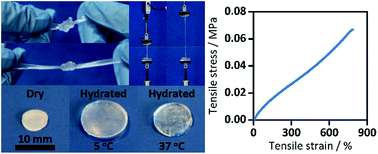Thermoresponsive, stretchable, biodegradable and biocompatible poly(glycerol sebacate)-based polyurethane hydrogels†
Abstract
Thermoresponsive, stretchable, biodegradable and biocompatible polyester-based polyurethane (PEU) hydrogels, based on poly(glycerol sebacate) pre-polymer and poly(ethylene glycol)s of different molecular masses were synthesized by a facile solvent-based two-step method. The chemical and physical characteristics of the PEU hydrogels are tunable, enabling the design of various negatively thermosensitive, mechanically stable and biodegradable systems. The PEU hydrogels demonstrate reversible responses to a change in medium temperature from 5 °C to 37 °C, with the swelling ratio at equilibrium varying from 499% to 12%. The hydrogels have a tensile Young's modulus, ultimate tensile strength and elongation at break in the range of 0.02–0.20 MPa, 0.05–0.47 MPa and 426–623%, respectively, and show high stretchability and full shape recovery after compression. These are similar to the mechanical properties of adipose tissues. In vitro degradation tests show mass losses of 8.7–16.3% and 10.7–20.7% without and with the presence of lipase enzyme for 31 days, respectively. In vitro cell tests show clear evidence that some of the PEU hydrogels are suitable for culturing adipose-derived stem cells and dermal fibroblasts and hence for future soft tissue regeneration. The functionalities of the PEU hydrogels were also evaluated for potential applications in drug delivery, thermal actuation and ultralow power generation. The results demonstrate the versatility of these PEU hydrogels for a variety of biomedical and engineering applications.



 Please wait while we load your content...
Please wait while we load your content...